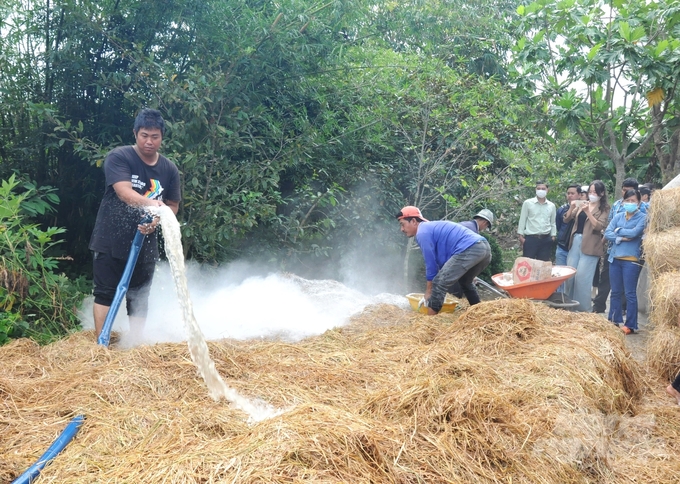November 24, 2025 | 14:39 GMT +7
November 24, 2025 | 14:39 GMT +7
Hotline: 0913.378.918
November 24, 2025 | 14:39 GMT +7
Hotline: 0913.378.918
From September 16 to October 22, 2024, as part of the Green Innovation Centers in Agriculture and Food (GIC) project, the Kien Giang Agricultural Extension Center organized 25 three-day training sessions for farmers. These sessions focused on managing and processing straw for straw mushroom production and compost production, while also promoting a circular economy within the agricultural value chain.
In these training sessions, farmers not only gained theoretical knowledge but also had the opportunity to visit practical models of straw mushroom production and organic composting processes. They also witnessed demonstrations of organic fertilizer mixing machines.

Utilizing straw to cultivate straw mushrooms and produce organic fertilizer not only helps increase farmers' incomes but also reduces environmental pollution and greenhouse gas emissions. Photo: Trung Chanh.
Through the training techniques offered, the project aims to support farmers in carrying out the project for the sustainable development of 1 million hectares of high-quality, low-emission rice cultivation. This project is linked to green growth in the Mekong Delta region, with a target set for 2030 specifically in Kiên Giang province.
Moreover, the GIC Project plays a crucial role in enhancing rice cultivation systems by promoting sustainable practices. This approach not only improves the efficiency of resource management and utilization but also boosts farmers' resilience and adaptability to the challenges posed by climate change.
According to scientists, each hectare of rice land generates approximately 6 tons of straw after harvesting. If this straw were to be collected and processed into compost, then returned to the fields, it could significantly enrich the soil. Specifically, this process could provide essential nutrients amounting to between 78 and 91 kg of urea, 37 to 45 kg of super phosphate, and 150 to 180 kg of potassium oxide (K₂O).
However, many farmers traditionally resort to burning or burying the straw into the soil, particularly in flooded conditions. This practice not only contributes to environmental pollution and the emission of greenhouse gases but also represents a significant waste of valuable nutrients such as nitrogen (N), phosphorus (P), and potassium (K), as well as organic matter found in the straw. Consequently, these practices lead to the gradual depletion of soil nutrients, resulting in soil degradation and reduced fertility over time.
Mr. Nguyen Van Huynh, the Director of the Phu Hoa Youth Agricultural Service Cooperative, located in Tan Hoi Commune of Tan Hiep District in Kien Giang Province, has announced that the cooperative is actively participating in the initiative for 1 million hectares of high-quality rice cultivation, encompassing an area of 620 hectares. As part of this effort, the cooperative has kicked off a pilot project covering 50 hectares for the autumn-winter rice season of 2024. This pilot field is implementing synchronized mechanization along with advanced techniques aimed at reducing emissions in rice production. Early results from this initiative indicate that it is yielding high effectiveness.
Additionally, through a training program focused on straw management and processing - part of the GIC Project and conducted by the Kien Giang Agricultural Extension Center - farmers will acquire valuable knowledge on how to maximize the utilization of straw. They will learn methods for using this resource to cultivate straw mushrooms and produce organic fertilizer. This approach not only enhances their income potential but also plays a significant role in reducing greenhouse gas emissions.

Farmers participate in training on straw processing techniques for cultivating straw mushrooms to increase their income. Photo: Trung Chanh.
Kien Giang Province has officially registered to participate in the sustainable development initiative aimed at cultivating 1 million hectares of high-quality, low-emission rice, which is closely linked to green growth in the Mekong Delta region by the year 2030. The province has committed to an area of 200.000 hectares for this project. The provincial agricultural authorities have selected 12 out of the 15 districts and cities in the region to implement this initiative. These include Giang Thanh, Kien Luong, Hon Dat, Tan Hiep, Chau Thanh, Giong Rieng, Go Quao, An Bien, An Minh, U Minh Thuong, Vinh Thuan and Rach Gia.
For the year 2024, the targeted implementation area is 60.000 hectares. This will primarily be based on the existing infrastructure of cooperatives and the knowledge gained by farmers who have undergone training in advanced rice cultivation techniques. This training is part of the broader sustainable agriculture transformation project in Vietnam, known as VnSAT.
The goal is to expand the area to 100.000 hectares by 2025 and gradually reach 200.000 hectares by 2030, focusing on high-quality, low-emission rice cultivation. Throughout this process, there will be a significant demand for the collection and processing of straw after each rice harvest.
Translated by Phuong Linh
/2025/11/22/4018-4-213342_747.jpg)
(VAN) The Mekong Delta Agricultural Experts Club has attracted 143 experts and researchers to participate in providing consultancy and contributing initiatives to the development of one million hectares of high-quality rice.

(VAN) Ca Mau’s development of OCOP products opens a path to increasing cooperatives value, helping boost income, expand markets, and affirm collective economy's role.

(VAN) Turning seemingly ordinary coconut shells into unique jewelry and artwork, Nguyen Bang Nhi spreads the value of local culture through her brand, Cocohand.

(VAN) Results from the Sustainable Durian Model Project in Dak Lak have confirmed the critical role of Yara Viet Nam in transferring advanced nutritional solutions to farmers.

(VAN) In Tuyen Quang province, livestock farmers have introduced effective models and innovative practices that significantly strengthen African Swine Fever prevention and control efforts.

(VAN) This is the study conducted by IRRI and Can Tho University on the rice straw value chain in Mekong Delta showing an economic potential of more than 6.6 trillion VND/year.

(VAN) By participating in cooperative economics, many farmers in Tay Ninh have overcome hardship, mastered clean dragon fruit cultivation techniques.